New York Fashion Week A/W 2024: Tory Burch to Thom Browne
The best of New York Fashion Week A/W 2024, from consideration of silhouette at Tory Burch to an Edgar Allan Poe-inspired outing at Thom Browne
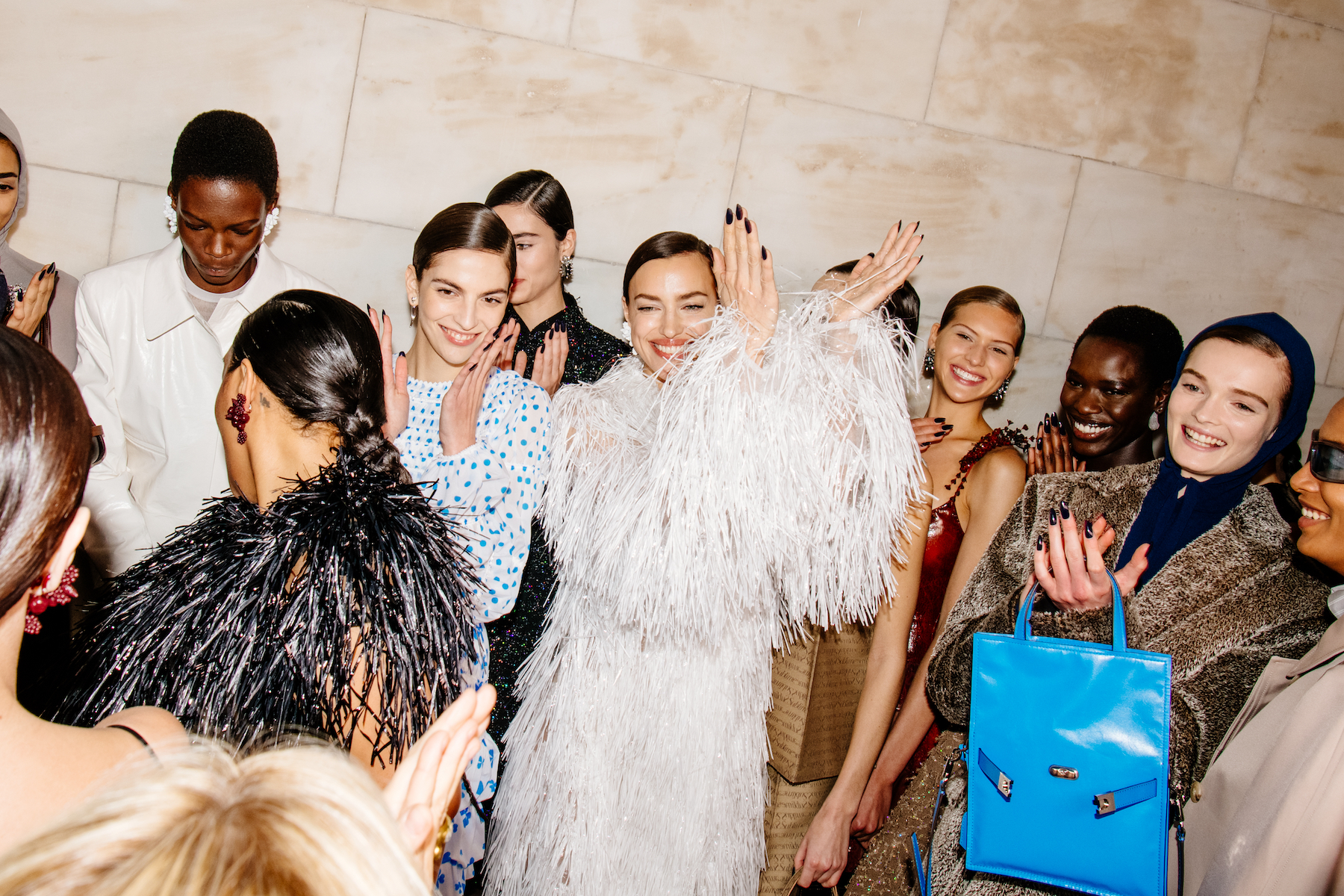
Tilly Macalister-Smith
New York Fashion Week A/W 2024 heralded the start of fashion month, which sees subsequent stopovers in London, Milan and Paris in the coming weeks. It was an energetic opening act: Peter Do’s sophomore collection for Helmut Lang began proceedings with a collection which mused on the dichotomy between armour and adornment, while Willy Chavarria – selected as part of the Wallpaper* USA 300 last year – rounded out the opening day with a collection which cemented him as one of the city’s most intriguing talents.
Meanwhile, Paris-based Ludovic de Saint Sernin made his New York Fashion Week debut with an ode to photographer Robert Mapplethorpe, while buzzy shows from Coach, Tommy Hilfiger, Michael Kors, Thom Browne and Tory Burch were among the season’s biggest hitters.
Here, reported from the shows, Wallpaper* fashion features editor Jack Moss and contributing editor Tilly Macalister-Smith select the best of New York Fashion Week A/W 2024.
The best of New York Fashion Week A/W 2024
Thom Browne

Thom Browne A/W 2024
Though Thom Browne’s latest show took place on Valentine’s Day – the holiday nodded to in the enormous heart-shaped box of flowers the designer grasped for his post-show bow – the inspiration for the collection itself was altogether darker, with Edgar Allan Poe’s haunting 1845 poem The Raven providing the season’s starting point. The poem tells the story of a man who after the death of his lover is visited by a talking raven, provoking a slow descent into madness; here, an altered version – with nods to Chesterfield puffers and silk moiré – was narrated by The Gilded Age actress Carrie Coon.
It made for fertile ground for the theatrical Browne, whose towering cast of characters had a gleefully creepy air, their ruffled hair shaped into enormous sculptural plaits or adorned with delicate black mourning veils. The palette was largely black and white, like a series of plays on the tweed blazer – whether checkered, or deconstructed and patchworked – or white coats over which a flock of black ravens were appliquéd. Ravens also appeared across the dramatic closing look, which comprised an enormous gold brocade cape, removed at the end of the show like a ‘beguiling golden bug’, as the notes described. Watching over it all was a tree-like figure clad in a 30-foot-high version of the brand’s Chesterfield puffer – another dramatic flourish from the designer, who can always be relied upon to put on a show. JM
Gabriela Hearst
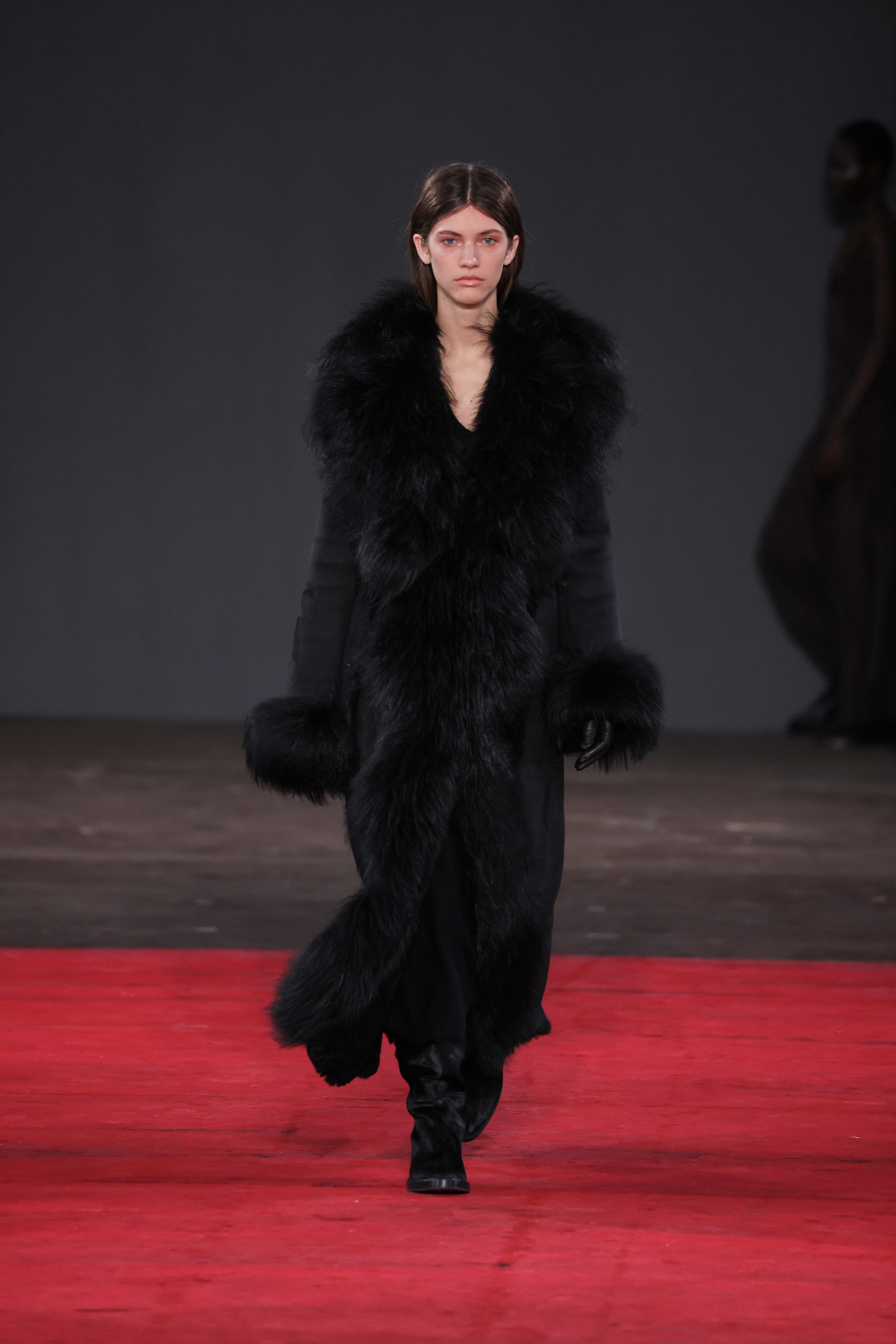
Gabriela Hearst A/W 2024
The dreamlike paintings of artist Leonora Carrington fueled Gabriela Hearst’s imagination this season. But, rather than lay claim to the artist as a source of inspiration, Hearst instead spotlighted a series of women through which she had learned about Carrington, from art historian and author Katy Hessel to journalist Jackie Wullschläger and writer Joanna Moorhead. ’Teaching us empathy and about how others live; and to dream up a better world for all,’ said Hessel of the surrealist artist.
There’s something especially seductive about Hearst’s clothes during a winter season, with the richness and decadence of enveloping shearlings and sweeping gowns worn with riding boots. And then you remember – it’s Hearst, so it can’t be shearling, and you find that it’s actually shredded post-consumer recycled cashmere from Italian cashmere jumpers. (Hearst has made the seasonal commitment to deliver a document capturing the origin and composition of all the fabrics in the show, along with her show notes). For this collection, it stated that the clothes were constructed of 100 per cent natural fibres. These included fine cashmere corduroy (the first time anyone has produced this fabric), liquid silk velvet woven on historical French velvet looms only operated by one mill in Lyon, and a printed wool gauze based on flowers Hearst had found on vacation. TMS
Wallpaper* Newsletter
Receive our daily digest of inspiration, escapism and design stories from around the world direct to your inbox.
Michael Kors
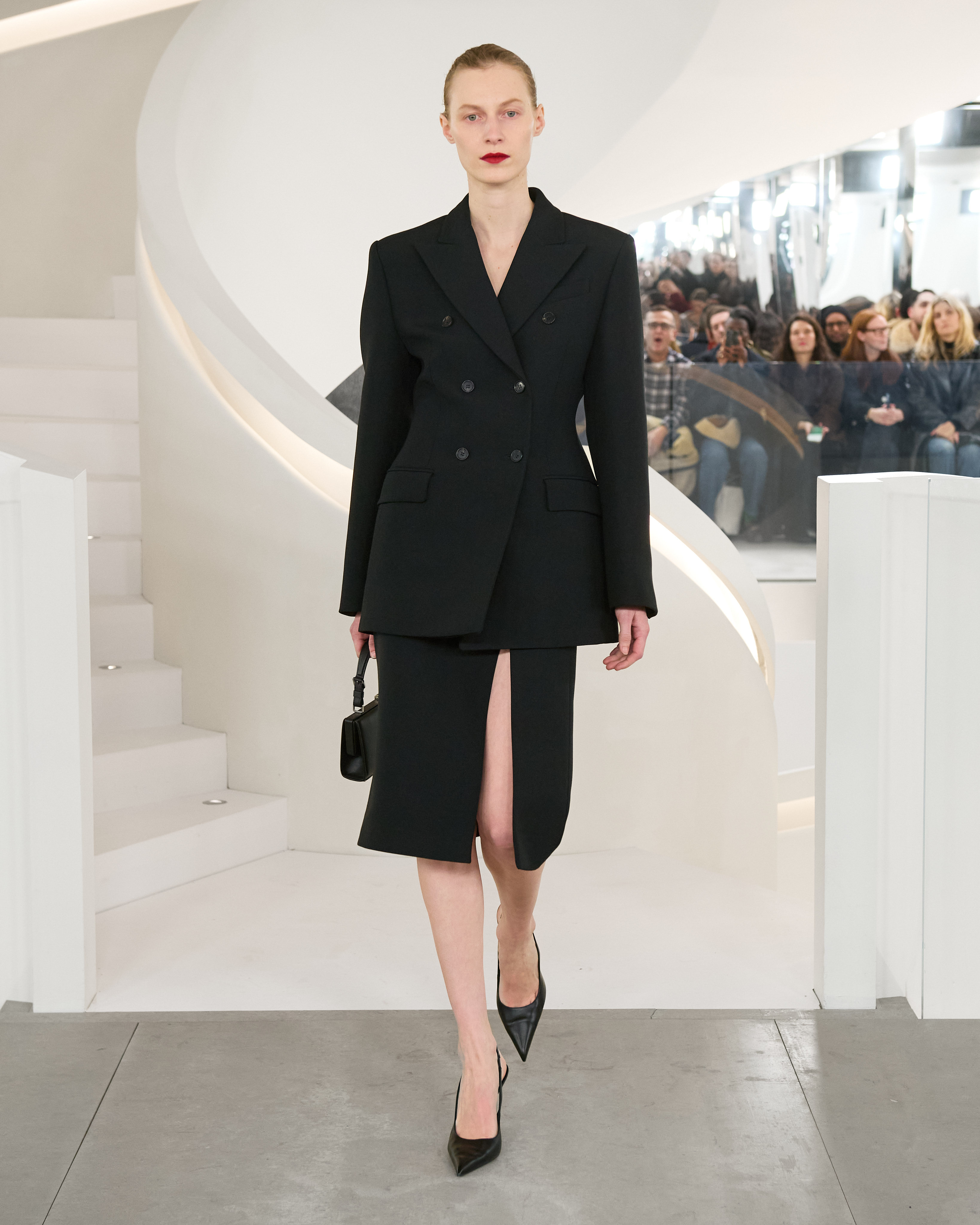
Michael Kors A/W 2024
Michael Kors titled his A/W 2024 collection ‘Timeless’, reflecting the American designer’s ongoing desire to refine the building blocks of a woman’s wardrobe over pursuing fleeting trends. Taking place at the former Barneys New York space in Chelsea – a longtime pillar of American fashion, before it shuttered in 2020 – the designer said it was a collection which doubled down on the foundations of the eponymous label (something several New York designers seem to be doing this season). ‘One of my hallmarks has always been fashion that stands the test of time,’ he elaborated.
So here was a collection of elegance and polish, one which spanned the gamut of garments which make up a woman’s wardrobe: nipped-waist double-breasted tailoring, leather jackets with soft shearling collars, pointed pumps, and even a hoodie. Flourishes of New York glamour, meanwhile, came in sequin adorned cardigans and lacy slip dresses, or the expansive fluffy overcoats in shades Kors described as ‘dusty makeup shades’, inspired by insouciant 1930s glamour. ‘When we talk about what’s timeless and what endures – it’s quality, it’s simplicity, it’s sophistication,’ said Kors. ’It’s clothes that make you feel confident and powerful.’ JM
Tory Burch

Tory Burch A/W 2024
Tory Burch ended Monday evening’s proceedings with an evening-time takeover of the New York Public Library on Fifth Avenue. Erecting a silver runway along one of the building’s ornate walkways, Burch said that this season she wanted to explore silhouette and proportion in new ways, a continuation of the recent gear-shift for the designer which has seen her embrace a more freewheeling, experimental approach to her eponymous label. ‘Internally there was a lot of discussion around the concept of being ”on brand” and that wasn’t interesting to me because it inhibits creativity. So, over the last five years, I’ve smashed that concept,’ she recently told Wallpaper*.
So there was an intriguing strangeness to this season’s collection, whereby bonded, heat-sealed garments – like a series of tweed-like dresses and overcoats which opened the show – had an architectural silhouette though through their construction (which Burch noted started from the inside out) were surprisingly light and fluid in movement. Textural richness, meanwhile, came in fronds of tassels or twisting ruffles which curled around the hem of delicate diaphanous mini dresses, or sleeker hair-on-hide dipped outerwear. Other garments had a more sensual air, like the semi-sheer skirt worn by Emily Ratajkowski – its surface gently decorated with a shimmering degradé motif – combined in the show with a faux croc bodysuit and the brand’s vertiginous new ‘Pierced’ pump (a style complete with a sweeping abstract metal adornment which will no doubt be ubiquitous come next season). ‘We were thinking about making the everyday sublime,’ concluded Burch. JM
Coach
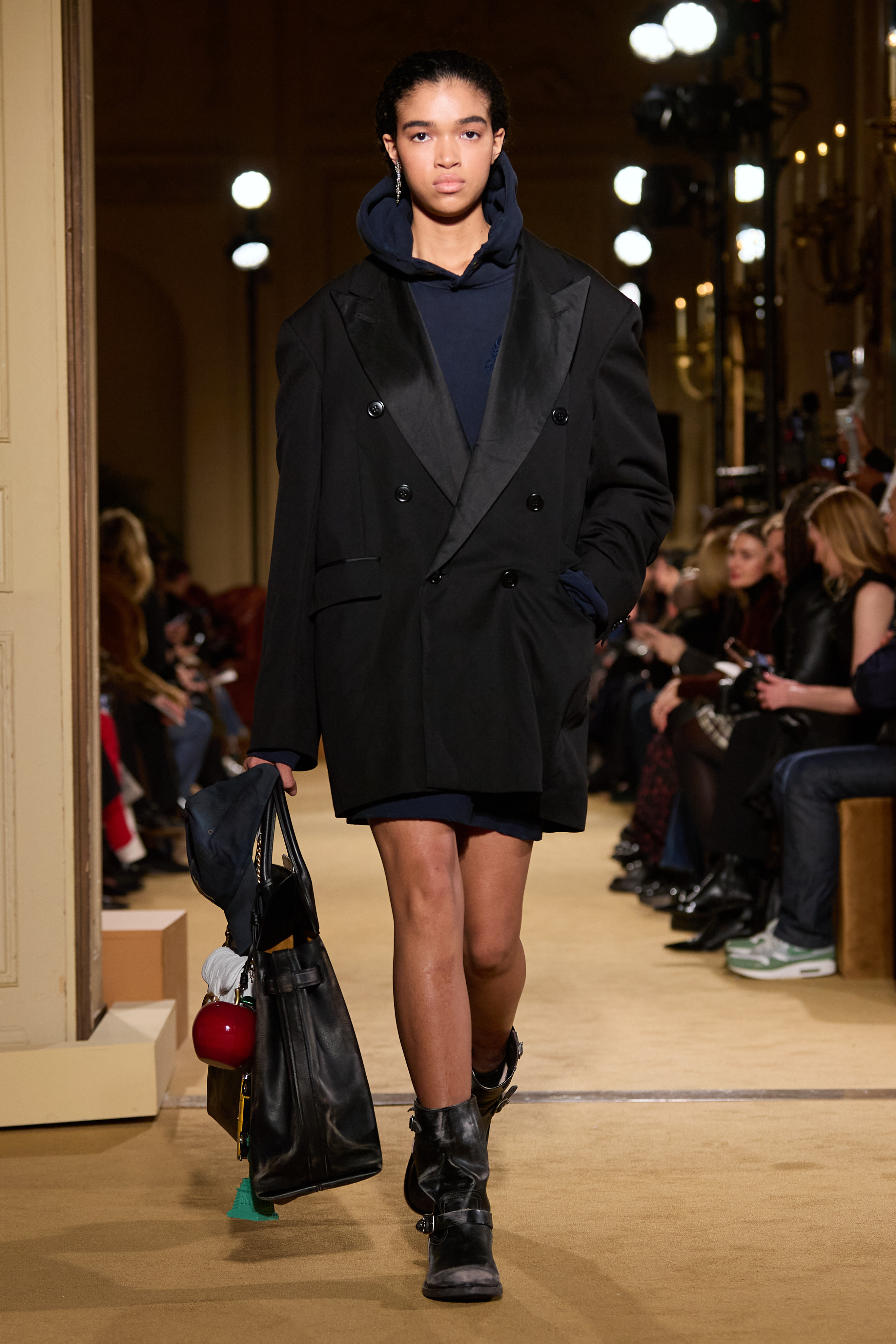
Coach A/W 2024
Presented in the regal James B. Duke House on New York’s Upper East Side – long synonymous with the city’s blue-blooded elite – Stuart Vevers presented a collection which clashed American classicism (epitomised in the show notes by John F. Kennedy Jr and Carolyn Bessette) with the ‘unvarnished’ eclecticism and spontaneity of the city’s streets. Ruffled debutante dresses in taffeta and tuxedo blazers were crumpled, as if their wearer had been up all night, paired with heavy worn-in leather boots as models stomped through the building’s downstairs salons. In their hands or slung over the shoulder, heaps of bags and accessories, including tourist charms of the Statue of Liberty and the city’s symbolic apple, as well as Yankee caps, perhaps New York’s most enduring accessory.
Elsewhere, Vevers offered a highly desirable wardrobe of pieces primed for the demands of city life; among them, elongated, gently oversized trench coats, shearling and tasselled leather jackets, and more playful sweaters adorned with bows and ducks. It made for one of the designer’s strongest outings at the American mega-brand for some time, and a decisive return to its New York origins, where the brand was founded in 1941. ‘We’re based in New York and embracing it – fashion escapism is not our style,’ said Vevers, who noted the collection originally began with thinking about New York love stories, like those by writer Nora Ephron. ‘[Her] tension between something romantic and picturesque and something very real and spontaneous is unique to New York, I think. And it captures the mood of the collection.’ JM
Zankov
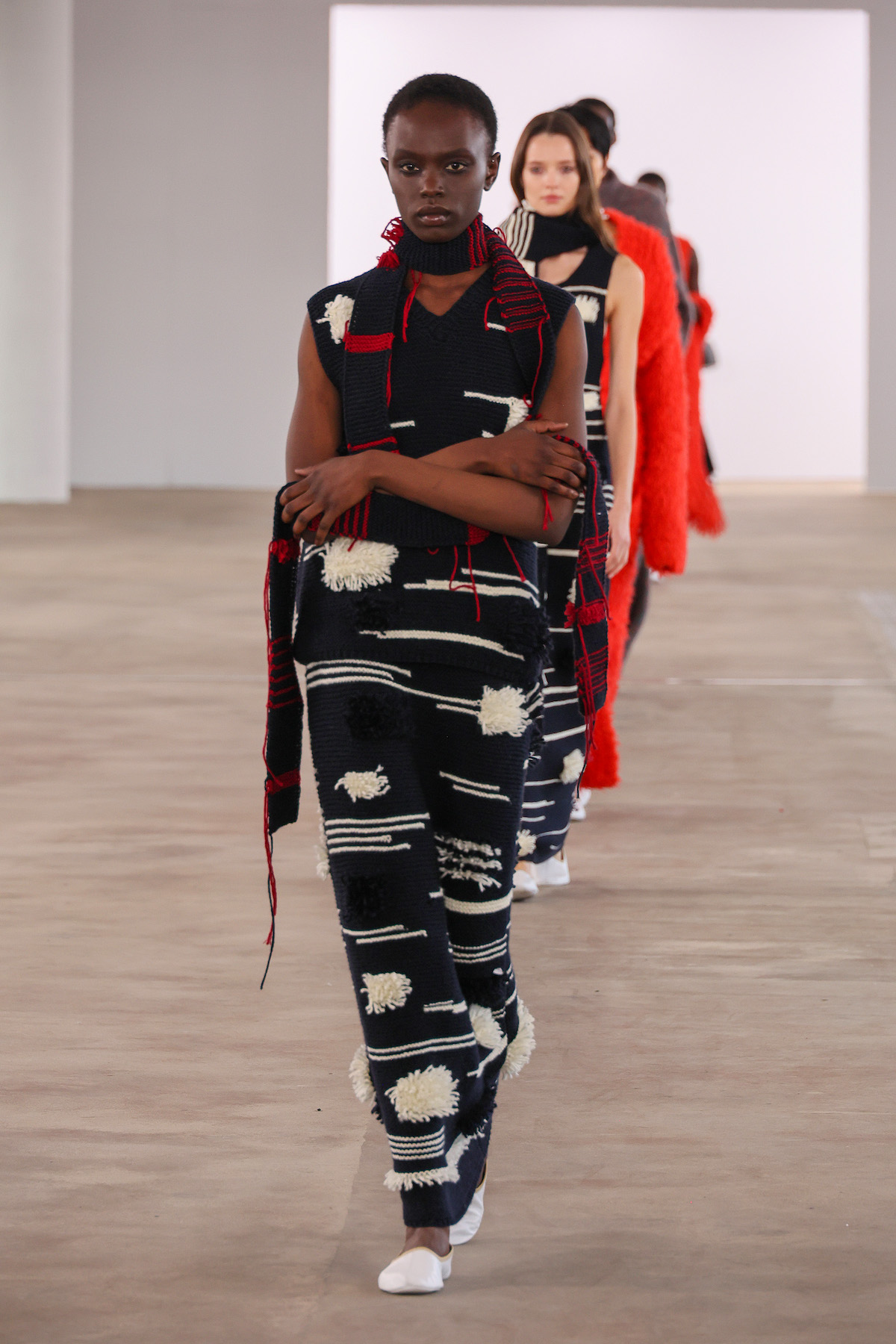
Zankov A/W 2024
‘Seduction and gusto!’ exclaimed Henry Zankov of the mood of his A/W 2024 collection at his presentation on Monday morning, as models and fans swirled around the designer in the Chelsea space. ‘Strong saturated colors with strong energy for evening,’ he expanded. ’That’s how the seduction happens.’ In his first outing since winning runner up at the CFDA/Vogue Fashion Fund in October 2023, Zankov’s presentation was ratcheted up a notch. The street outside the skylight-studded gallery was lined with black suburbans (a tell-tale sign of a ‘moment’), while inside, teams of PRs with headsets ushered guests to the light-flooded atrium. Alongside brand hallmarks such as his perforated knits and intarsias, the clothes took on a new dimension: subtly engaging colour mixing, a wealth of texture, and some new categories. The tufted hand-worked ‘pom pom’ knits; the feathery shredded alpaca tomato-orange dress and scarf; and the mouline hand knit crew-neck were all asking to be stroked. A red deconstructed jumper, meanwhile, appeared to have been repurposed – but effortlessly – so that the model's head popped out of an arm hole while its sleeves were knotted at the hip. Scarves were a focal point: a moss green cashmere coat had one built into its neckline, a device he used again on a chartreuse fine gauge knit. TMS
Ulla Johnson
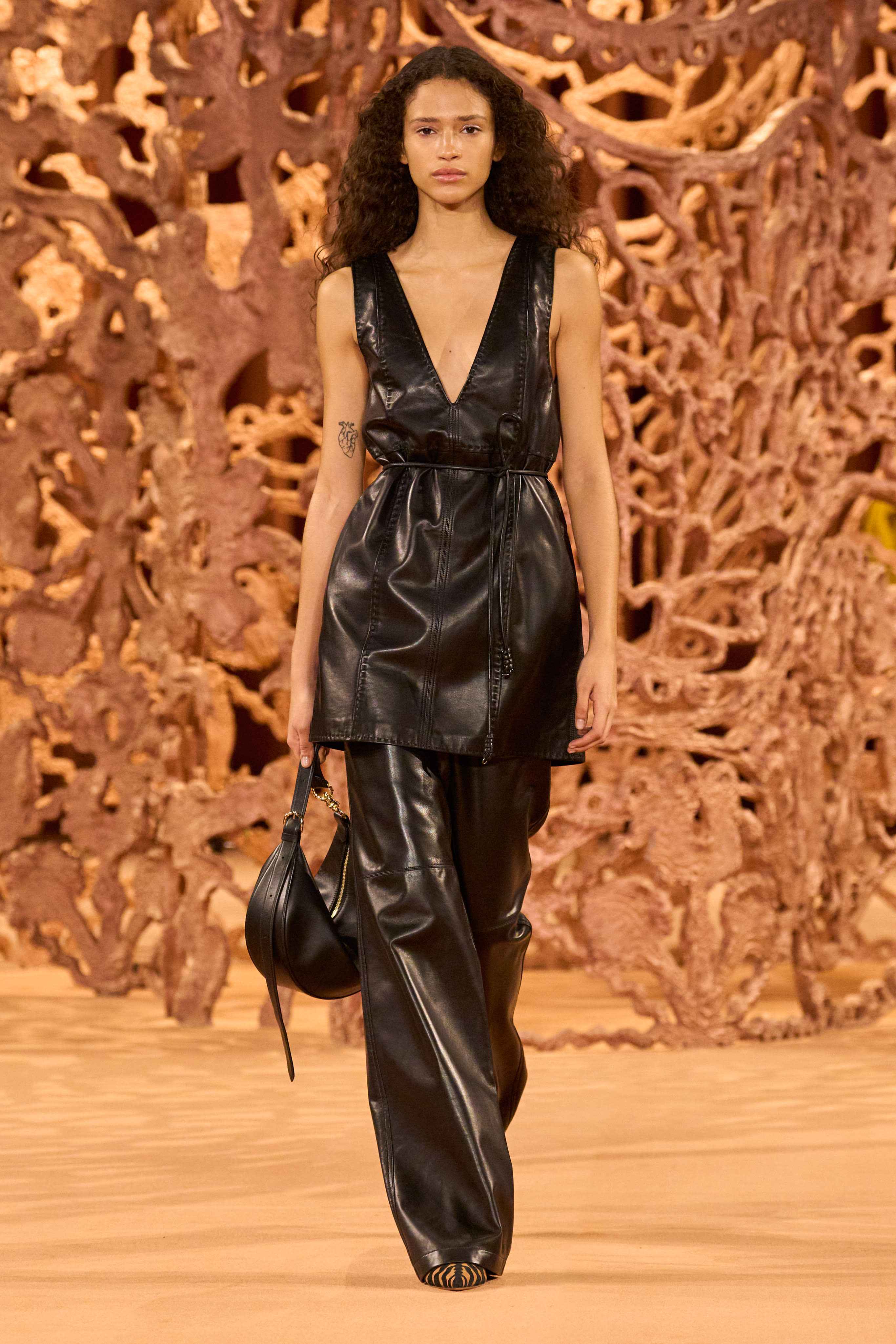
Ulla Johnson A/W 2024
A soft-on-the-senses welcome: sandy deep pile carpet and soaring terracotta curtains absorbed the chatter as guests arrived for Ulla Johnson’s show on Sunday morning. In the hushed, soothing space, a towering sculpture by Mississippi-born artist Andrew Ondrejcak made in collaboration with Brooklyn-based artist Abby Cheney appeared as if a delicate filigree ring had been blown up into new giant proportions.
Raven Leilani, author of Luster, which enjoyed much buzz following its 2020 publication, wrote in the show notes: ’In adornment, there is also fantasy… making something beautiful requires something of you.’ Indeed, the hand of the artisans with whom Johnson has built years-long partnerships with all over the world were front and centre in the sequin and bead embroideries that came to life as a black dress and pencil skirt, as well as the use of crochet. Fluidity, romance, movement – Johnson’s handwriting – was ever present, but this season, punctuated by a vibrant violet spongy wool (particularly mouthwatering layered under a chartreuse trench), while her sellout quilted coat appeared in moss green with golden brocade print. Cleverly, tailoring (notably a pantsuit in a textured pinstripe) and denim (a dramatically waisted jean jacket won here) spoke the same feminine vernacular. An unexpected entry came in the form of leather pants, which might be the most desirable we’ve seen in some time. TMS
Ludovic de Saint Sernin
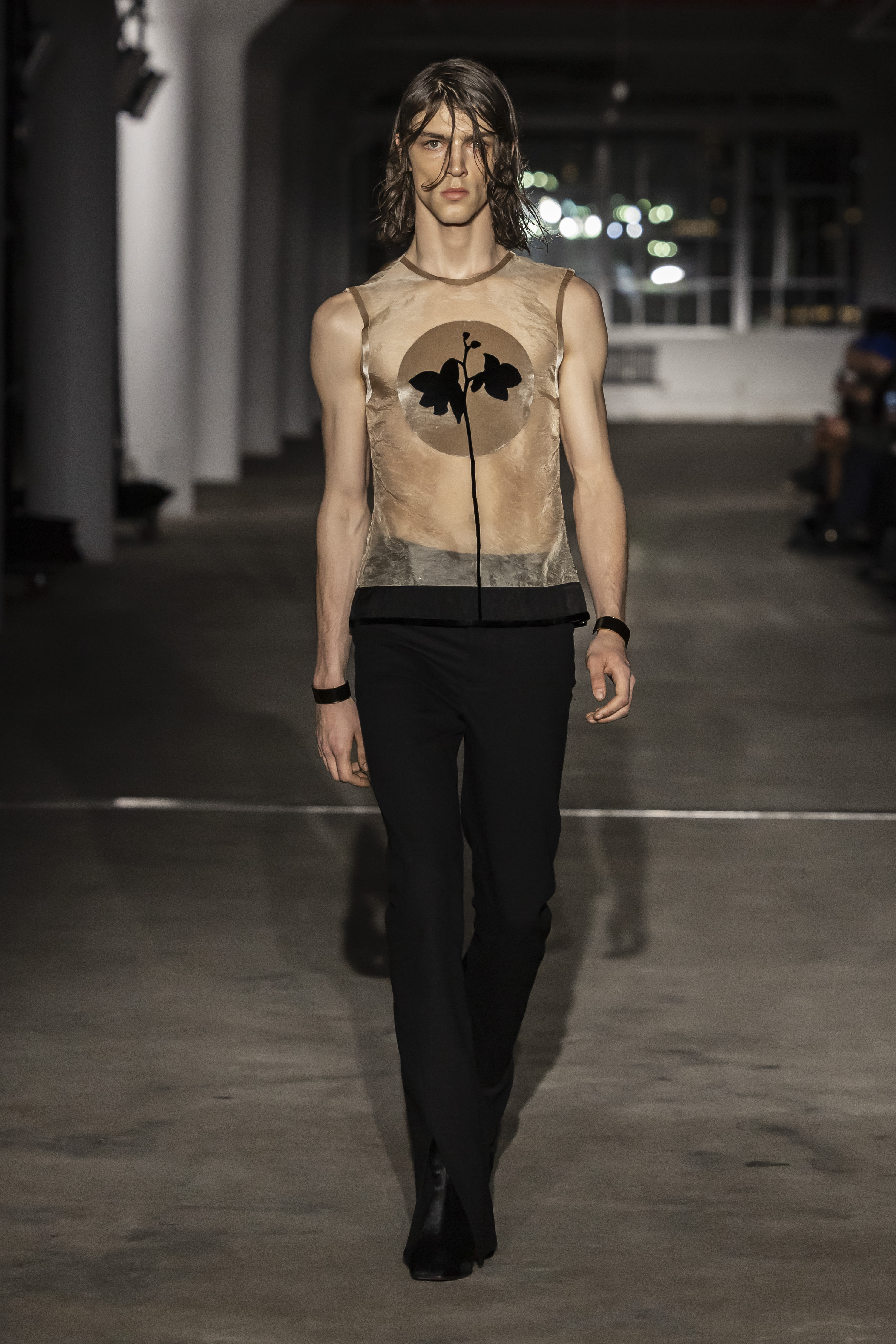
Ludovic de Saint Sernin A/W 2024
In the days prior to his first show at New York Fashion Week (previous seasons have seen the Belgian designer show in Paris, where remains based) Ludovic de Saint Sernin teased a collaboration with the Robert Mapplethorpe Foundation. In particular, the American photographer’s flower photographs, with De Saint Sernin finding inspiration in Mapplethorpe’s description of these sensually charged works that ‘beauty and the devil are the same thing’. Such a juxtaposition provided the collection’s impetus, seeing Mapplethorpe’s delicate stamens and blooms adorn sheer handkerchief tops and skirts which exposed the body beneath, or slinky, contouring chainmail dresses. Meanwhile, more provocative frissons of kink, inspired by Mapplethorpe’s portraiture and patronage of queer BDSM bars like The Mineshaft, came in lace-up leather underwear and trousers, the latter sliced down the back to reveal the models’ behinds (his riff on the Alexander McQueen bumster trouser). Other eyelet-studded pieces, a longtime signature of the designer, adorned harness-style tops and underwear, as well as dresses which wrapped and twisted around the body like a series of stacked leather belts. After the models stomped around for their finale walk, it was De Saint Sernin’s own turn to take a spin around the runway. Backdropped by the twinkling lights of the city beyond, he looked more than at home – as for whether he’s becoming a permanent fixture, watch this space. JM
Area
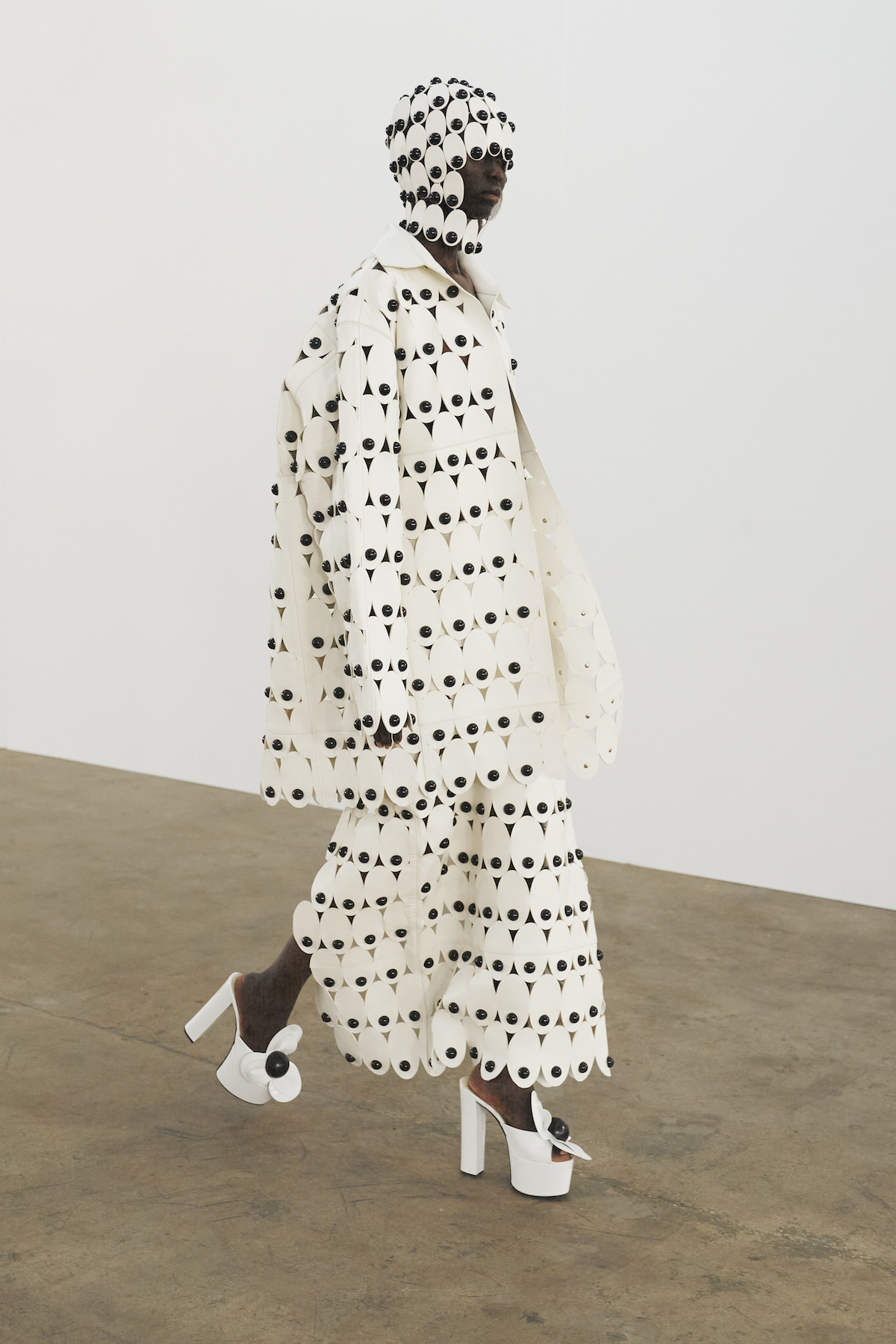
Area A/W 2024
A surreal outing from New York-based label Area saw designer Piotrek Panszczyk adorn gowns with hundreds of ‘googly eyes’ – the cartoonish spinning eyeballs which adorn greeting cards and craft tables. Across the collection, they appeared in miniature or oversized iterations, sprouting over skirts or reimagined in leather and shiny silver studs (they also seemed to transform a Dalmatian-style print, which covered monastic hooded gowns and baggy shirting). Panszczyk noted inspiration from both the surrealist movement of the 1920s and 1930s, as well as Pop Art, as inspiration points – the latter evoked in colourful cartoonish flowers, studded with Area’s signature crystal adornment. Indeed, crystals – with which the brand is synonymous – were here blown up in size, creating enormous necklaces or tasselled skirts which could be heard clattering as the model walked. If these more outré pieces might only be reserved for red carpets and music videos, crystal-studded jeans and slinky Area-branded tank tops will no doubt have a wider appeal, particularly with the announcement that the brand will be teaming up with Amazon’s luxury fashion division to sell its collections going forward. JM
Khaite
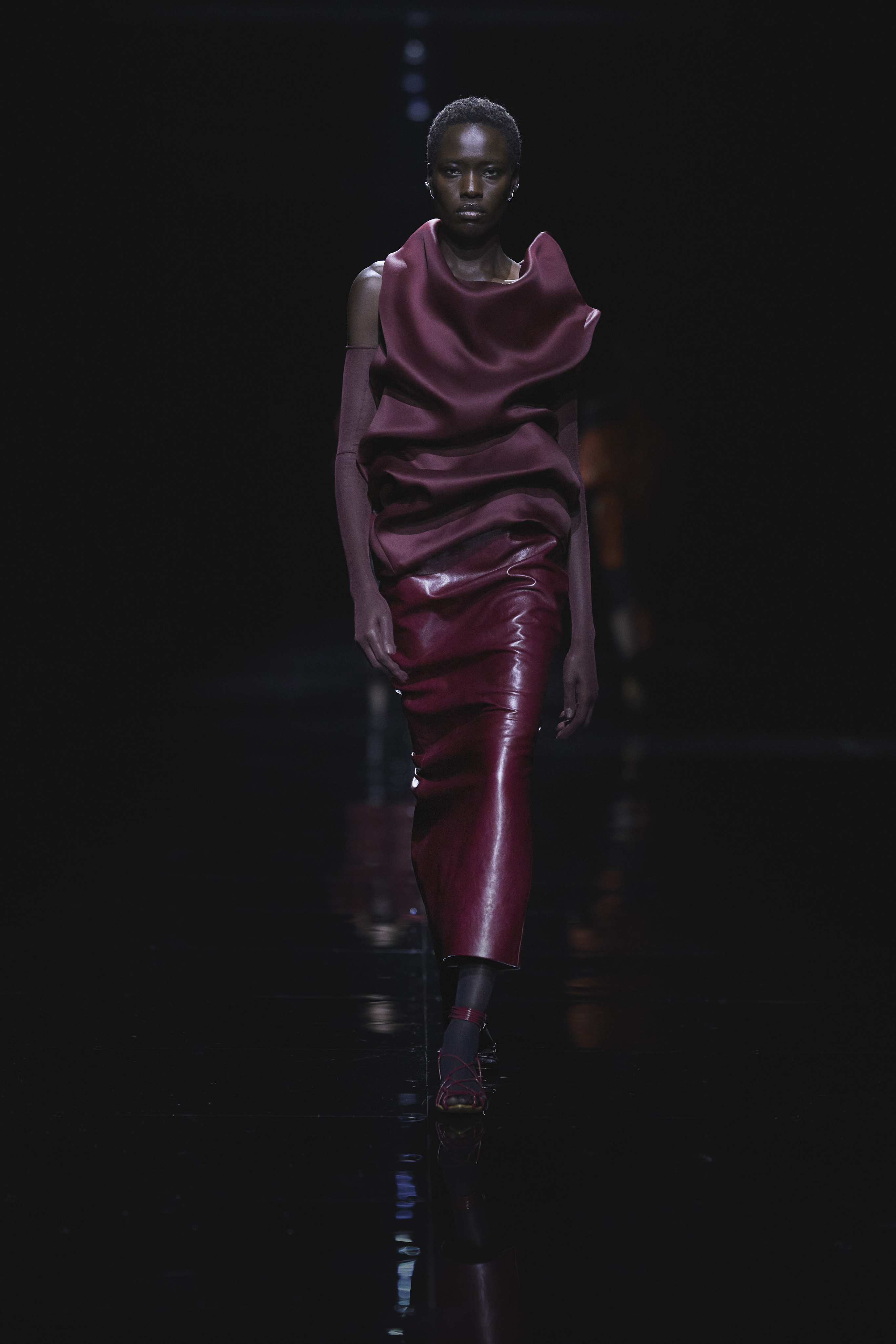
Khaite A/W 2024
A succinct personal statement from Catherine Holstein, typed on a postcard, greeted guests as they were seated for the show on Sunday evening at Chelsea Piers: generational legacy, and the ebb and flow of memory, has been preoccupying the designer. In contrast to the intimate welcome was the show’s set, a cavernous black interior, stretching into the darkness with a roped off oil-slick floor. New York has come to expect exceptional high gloss from this schedule fixture: lighting, set design (thanks to her husband, the architect Griffen Franzen, also responsible for the Wooster Street flagship), music by Jean Michel Derain, styling by Vanessa Traina, and general show mastery care of Prodject, who handle bringing events to life for the likes of Chanel and Prada, not forgetting the Met Gala. It’s a powerhouse team and the impact is always impressive. As to the clothes? On the one hand, the sharpness fans have come to know and covet: supple leather jackets with right-angle shoulders, a cropped boxy military peacoat, the just-the-right-amount-of-stiff tuxedo jacket. Even fox-fur chubby coats managed to retain perpendicular proportions and defined lapels. Then, on the other hand, lightness, fluidity and volume: duchess satin paper bag waists, a leather cocoon coat (wait for the price tag on that one) and – perhaps most impressive – the levity achieved in the gravity-defying silk gazar tops and skirts, which appeared to softly ripple away from the body. Evening looks, meanwhile, had a disheveled insouciance, which came through in the crinkled silk slips and gowns with sleeves formed from swathes of featherweight silk chiffon. TMS
Eckhaus Latta

Eckhaus Latta A/W 2024
In lieu of traditional collection notes, Mike Eckhaus and Zoe Latta have always offered a more abstract evocation of the season’s mood – here, they described the collection as ‘remembering America as though you’re standing on an orange milk crate hearing it crack under the weight of you thinking: “what will happen next?”’ Against the backdrop of floor-to-ceiling windows which looked out onto the New York City skyline, and a live soundtrack by Los Angeles-based musician Loren Kramar, including renditions of Lou Reed, Lana Del Rey and Frank Sinatra’s New York, New York, the collection itself seemed to muse on what American dressing, and being an American designer, means today (discussions this fashion week have centred on the particular challenges of showing on the New York schedule as a young designer, in part led by Carly Mark of Puppets + Puppets who has declared she will no longer show her collections in New York). In practice, like at Proenza Schouler, this meant a shift towards minimalism for the designers – or, at least, as stripped back as the brand’s undone aesthetic allows – honing in on the Eckhaus Latta codes with new clarity. Particularly strong were a series of surprisingly sharp shearling overcoats which opened the show (in a clash of textures, they were worn over featherweight sheer jersey tops), while shaggy ribbed knits will no doubt have real-world appeal. A mood of dishevelled glamour, meanwhile – a reflection, perhaps, of the show’s doomed America soundtrack – was struck in spaghetti-strapped silk slip dresses sliced away into streamers at the hem, or the iridescent fabric which was gently ruched and layered over mini dresses for the collection’s closing looks. JM
Proenza Schouler

Proenza Schouler A/W 2024
It was a stripped-back outing for Jack McCollough and Lazaro Hernandez at Proenza Schouler this season, a mood in part decided the evening before the show (the designers noted backstage that a series of more embellished and embroidered garments had for the time being been shelved). The pair explained the shift towards reduction as part of an ongoing desire to eschew the search for ephemeral trends which defined their early collections towards a more rigorous consideration of exactly who the Proenza Schouler woman is – evolution, rather than revolution. So there was sharply cut tailoring and enveloping overcoats which recalled 1990s minimalism, diaphanous dresses which looped seductively around the body (in part recalling the silhouettes of the previous season), while a series of blanket-like knits – sliced away into frayed cut-outs – provided the show’s closing looks. ‘It’s about beauty and enveloping layers, and comfort and soulfulness. It’s about protecting yourself in softness, beauty, luxury and sensuality,’ said Fernandez backstage of the collection. With it, the designers cemented themselves as one of New York Fashion Week’s most consistent talents, and arguably still the week’s biggest draw for travelling editors. ‘We want to be making clothes that don't feel throwaway, that you're going to own for a long time,’ concluded McCollough. ‘We think that's how people dress these days.’ JM
Tommy Hilfiger

Tommy Hilfiger A/W 2024
Could Tommy Hilfiger have chosen a more poignant location for his aptly named ’New York Moment’ show than Grand Central Station’s Oyster Bar? Unlikely. Outside the show, in the station’s famed cavernous cream marble atrium, onlookers jostled to catch a glimpse of their favourite TikTok celebs as well as Sofia Richie Grainge, Damson Idris, Sonam Kapoor, Junho Lee and Jon Batiste, who gave a finale performance that had the whole room on its feet. Inside, a surprisingly intimate affair came to life at ‘The Tommy’, a secret saloon bar serving martinis and champagne, where editors gathered around cocktail tables and Questlove played a soundtrack inspired by New York’s five boroughs. Since its inception, Hilfiger has always closely connected his brand identity to youth culture, in particular music, and this evening was no different. A slouchy, youthful, insouciant energy pervaded. And in case there were any doubt remaining as to the brand’s legacy, the clothes were a lesson in ‘classic American cool’ – its raison d'être.
Essentials of the American wardrobe were revisited with new freshness and relevancy, such as a black and white rugby shirt with generously proportioned sleeves. Chinos were cut to be roomy, hands slunk into pockets. Shirting layered under long line cardigans and trench coats felt effortless and relatable. A pleated skirt that fell below the knee, worn with block-heeled boots, read as a fashion silhouette that would translate into the real world. The shearling motorcycle jacket and oversized tweedy puffa will no doubt be popping up on wishlists. The show itself also marked a shift away from the see-now, buy-now approach, in order to adhere to the fashion week schedule – a move deemed necessary to accommodate the elevation of its clothing production which, with various Italian-sourced fabrics and more complex production, appropriately require a little more time. TMS
Willy Chavarria

Willy Chavarria A/W 2024
Willy Chavarria’s shows have a kind of inexplicable magic which has made him one of New York Fashion Week’s most intriguing talents (the American designer was selected as part of the Wallpaper* USA 300 last year). In part, it is because he has played the long game – his career comprised design roles at American mega brands like Ralph Lauren before starting his eponymous label – allowing him to forge Willy Chavarria the brand at a moment he was confident in his hand and design codes, which largely centre on the multiplicity of the New York street (where he now calls home) alongside his Mexican-American upbringing in Fresno, California. And, having shown for several seasons, it is paying off: the designer won the 2023 Menswear Designer of the Year at the CFDA awards and has become a red carpet fixture (Billie Eilish is a particular fan), while his collection will soon be stocked in Barney’s and Saks. It lent proceedings a buzzy, celebratory air, backdropped by rows of church candles and religious ephemera which have long been a reference point for the designer. Chavarria’s hallmarks continued to be honed – notably a voluminous silhouette, which at once recalls baggy streetwear and the abundance of traditional couture – though freshness was struck in new fabrications (like houndstooth wool used across leaner trousers and a highly desirable elongated overcoat) and mood of refinement, seeing sweaters slung elegantly around the neck or some brilliant tuxedo- style tailoring, dramatically pitched at the lapel. JM
Helmut Lang
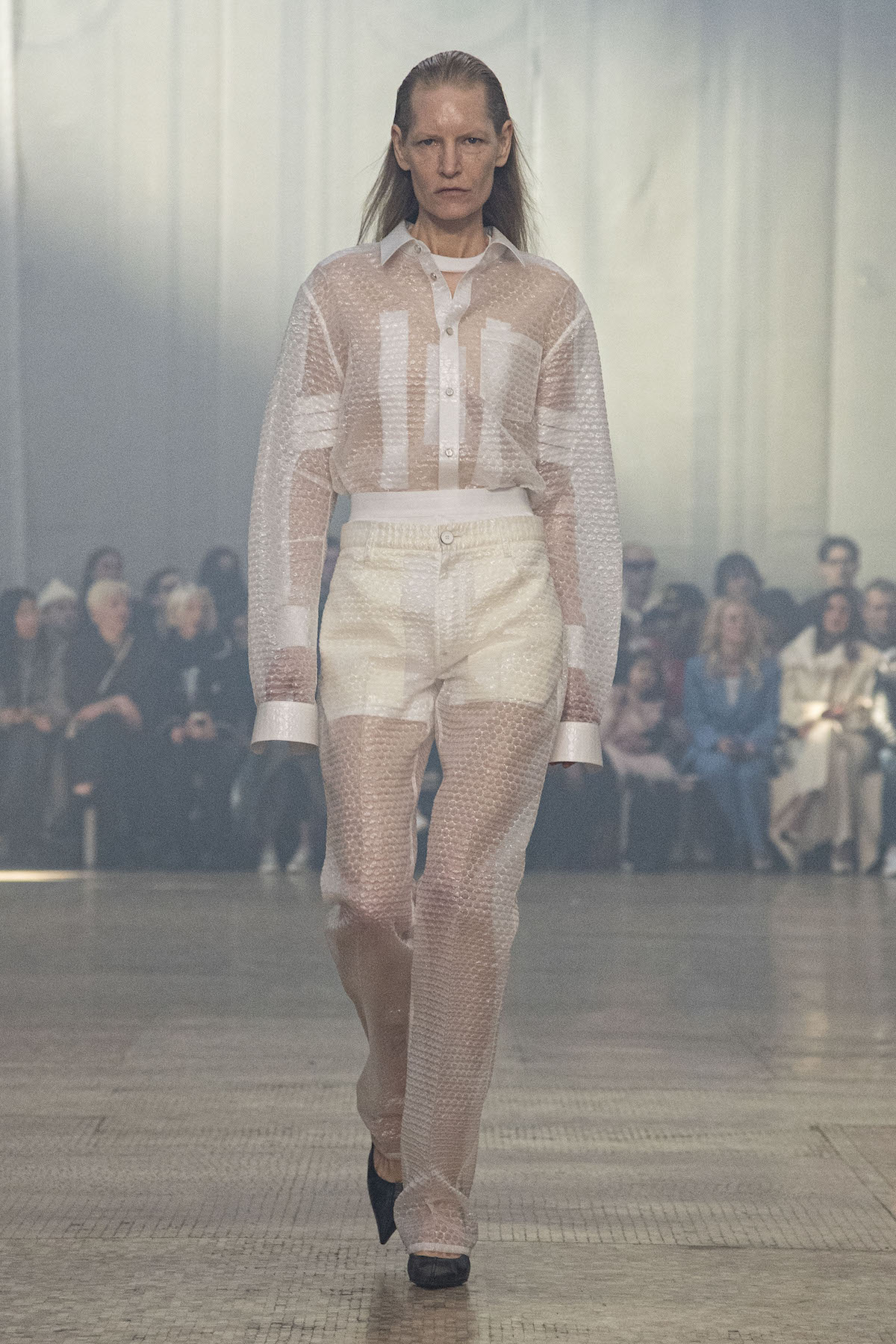
Helmut Lang A/W 2024
‘Protection versus projection,’ said Peter Do of his sophomore collection for Helmut Lang, which opened New York Fashion Week on Friday afternoon. ‘The way we protect ourselves is the way we define: armour or adornment?’ The designer continued this message via the printed collection notes, written in the same all-caps logotype Lang utilised in his own campaigns. So there were shirts and trousers which appeared crafted from bubble wrap – a suggestion of both protection and sensuality, exposing the inner workings of the garment, like pockets and zips beneath – while other knits rose up to engulf the face and body against the elements. A crescent-shaped bag, meanwhile, looked as though it was made for the model to rest her head on for comfort, like an aeroplane pillow, alongside technical vests which recalled the ‘bulletproof’ vests which appeared in Lang’s archival collections. As for the impetus behind the collection, Do said it emerged from a continuing observation of New York dress codes; the rigours of living in the city require both a need for protection and exhibition in the clothes people wear. ‘In a world of chaos, a system of dressing,’ the designer concluded of the collection, which though astutely mined hallmarks of the Helmut Lang archive, felt sometimes missing the unique frisson of sensuality and subversion which defined the brand’s seminal 1990s collections – a balance better struck by Do in his collections for his eponymous brand, which he will show later this month, on February 27, in Paris. JM
Stay tuned for more from New York Fashion Week A/W 2024
Jack Moss is the Fashion Features Editor at Wallpaper*, joining the team in 2022. Having previously been the digital features editor at AnOther and digital editor at 10 and 10 Men magazines, he has also contributed to titles including i-D, Dazed, 10 Magazine, Mr Porter’s The Journal and more, while also featuring in Dazed: 32 Years Confused: The Covers, published by Rizzoli. He is particularly interested in the moments when fashion intersects with other creative disciplines – notably art and design – as well as championing a new generation of international talent and reporting from international fashion weeks. Across his career, he has interviewed the fashion industry’s leading figures, including Rick Owens, Pieter Mulier, Jonathan Anderson, Grace Wales Bonner, Christian Lacroix, Kate Moss and Manolo Blahnik.
-
 Tour the best contemporary tea houses around the world
Tour the best contemporary tea houses around the worldCelebrate the world’s most unique tea houses, from Melbourne to Stockholm, with a new book by Wallpaper’s Léa Teuscher
By Léa Teuscher
-
 ‘Humour is foundational’: artist Ella Kruglyanskaya on painting as a ‘highly questionable’ pursuit
‘Humour is foundational’: artist Ella Kruglyanskaya on painting as a ‘highly questionable’ pursuitElla Kruglyanskaya’s exhibition, ‘Shadows’ at Thomas Dane Gallery, is the first in a series of three this year, with openings in Basel and New York to follow
By Hannah Silver
-
 Australian bathhouse ‘About Time’ bridges softness and brutalism
Australian bathhouse ‘About Time’ bridges softness and brutalism‘About Time’, an Australian bathhouse designed by Goss Studio, balances brutalist architecture and the softness of natural patina in a Japanese-inspired wellness hub
By Ellie Stathaki
-
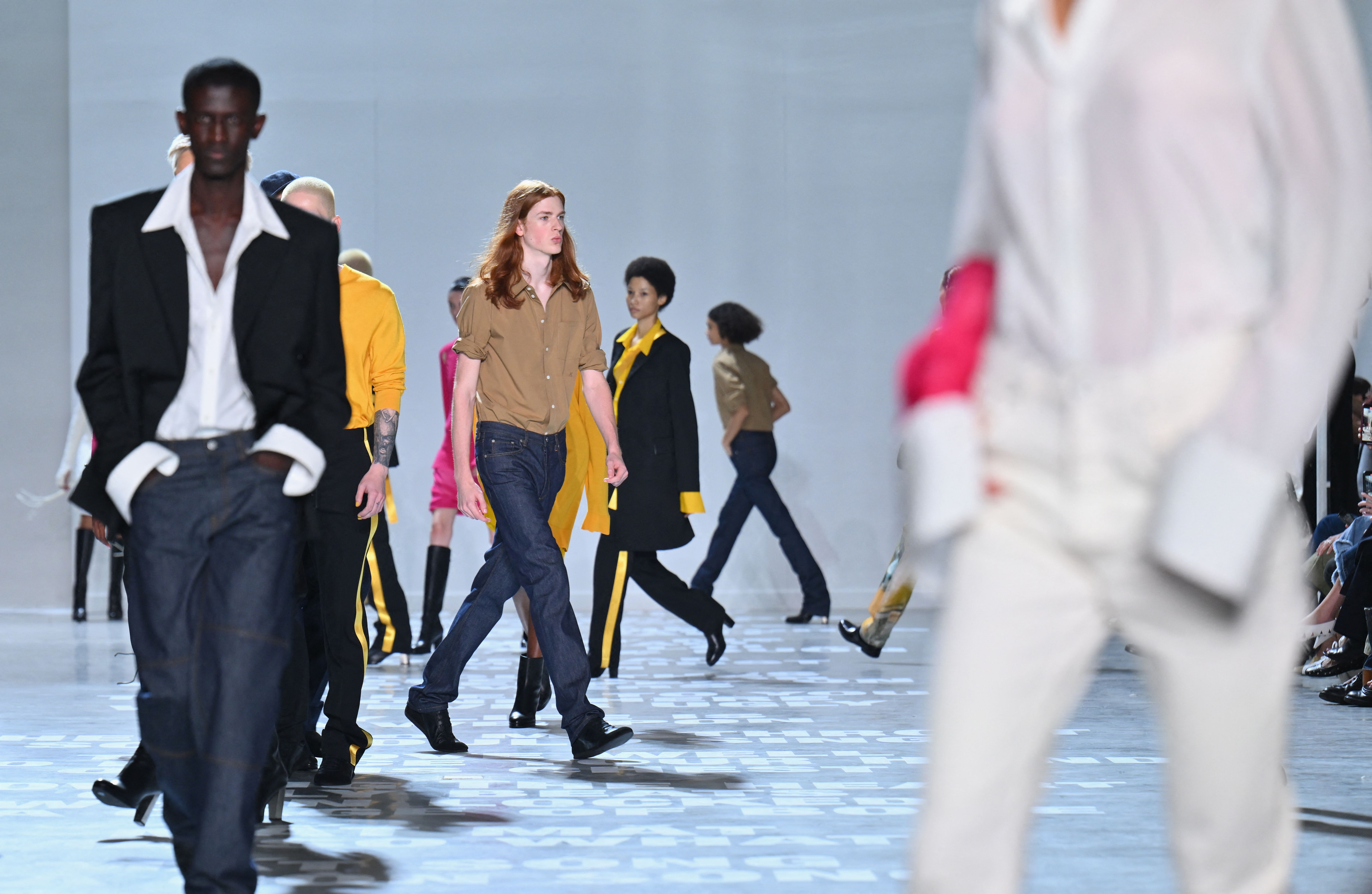 Peter Do’s Helmut Lang debut recalled the freedom of the open road
Peter Do’s Helmut Lang debut recalled the freedom of the open roadPeter Do introduced his vision for Helmut Lang at New York Fashion Week with a collection that began from memories of teenage road trips. Here, he describes the collection in his own words
By Tilly Macalister-Smith
-
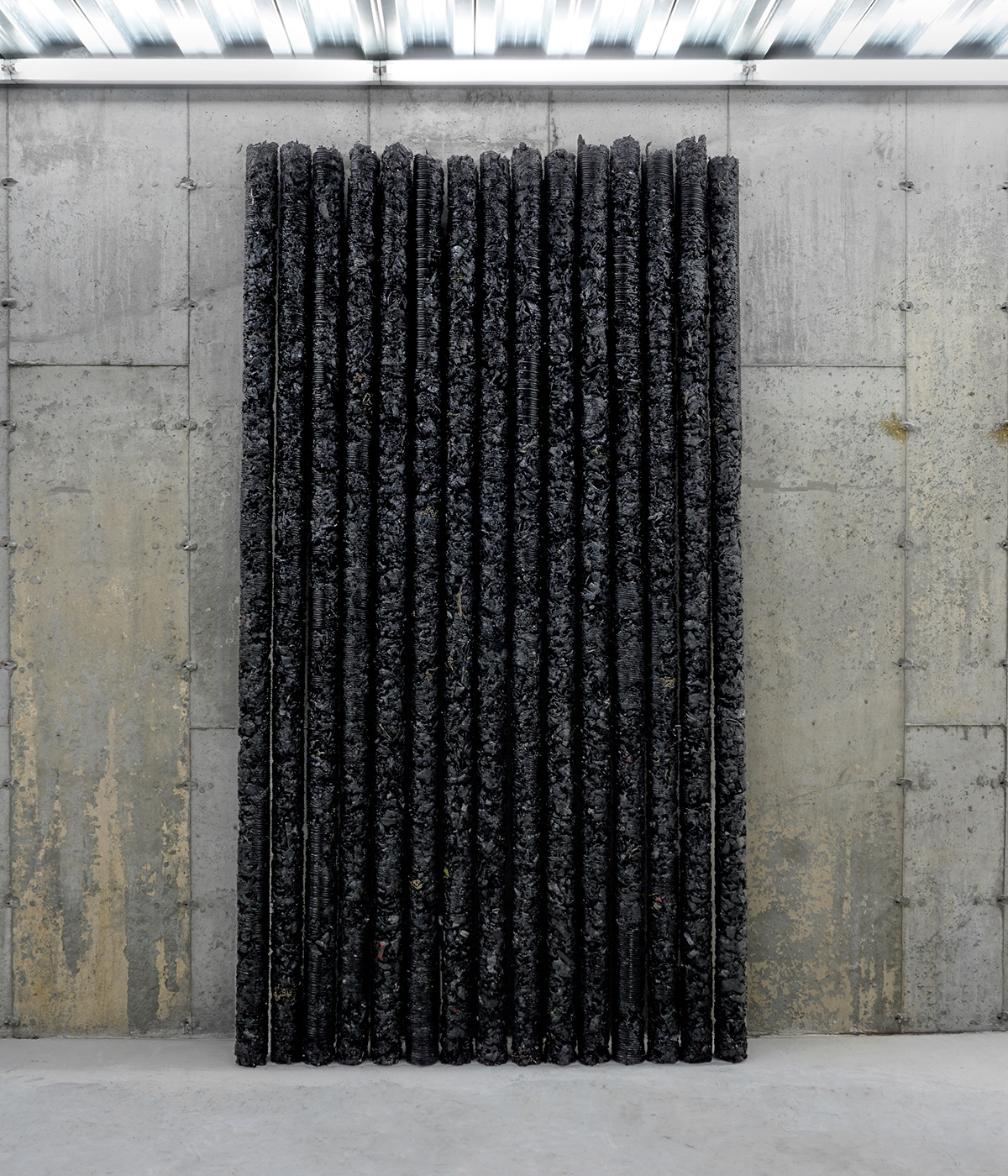 Helmut Lang creates sculptures from surplus Saint Laurent
Helmut Lang creates sculptures from surplus Saint LaurentA stacked series of pillars, formed from unfinished jewellery designs and clothing prototypes are on display at the Paris maison's Rive Droite concept store
By Laura Hawkins